Teachers College Press
Research and Practice in Social Studies Book Series
Research and Practice in Social Studies Book Series
In 2019, I was invited to create and edit the Research and Practice in Social Studies book series for Teachers College Press. Since then, I have worked with many talented scholars to publish books that are forward-thinking and of interest to both practitioner and scholarly audiences.
The series is particularly interested in books that address civic education, equity, and critical approaches to disciplinary instruction. To read more about the series, visit the series page on the TC Press website.
The series is particularly interested in books that address civic education, equity, and critical approaches to disciplinary instruction. To read more about the series, visit the series page on the TC Press website.
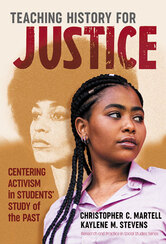
Teaching History for Justice: Centering Activism in Students' Study of the Past by Christopher Martell and Kaylene Stevens (2021)
Over the past two decades, various scholars have rightfully argued that we need to teach students to “think like a historian” or “think like a democratic citizen.” In this book, the authors advocate for cultivating activist thinking in the history classroom. Teachers can use Teaching History for Justice to show students how activism was used in the past to seek justice, how past social movements connect to the present, and how democratic tools can be used to change society. The first section examines the theoretical and research foundation for “thinking like an activist” and outlines three related pedagogical concepts: social inquiry, critical multiculturalism, and transformative democratic citizenship. The second section presents vignettes based on the authors’ studies of elementary, middle, and high school history teachers who engage in justice-oriented teaching practices.
Over the past two decades, various scholars have rightfully argued that we need to teach students to “think like a historian” or “think like a democratic citizen.” In this book, the authors advocate for cultivating activist thinking in the history classroom. Teachers can use Teaching History for Justice to show students how activism was used in the past to seek justice, how past social movements connect to the present, and how democratic tools can be used to change society. The first section examines the theoretical and research foundation for “thinking like an activist” and outlines three related pedagogical concepts: social inquiry, critical multiculturalism, and transformative democratic citizenship. The second section presents vignettes based on the authors’ studies of elementary, middle, and high school history teachers who engage in justice-oriented teaching practices.
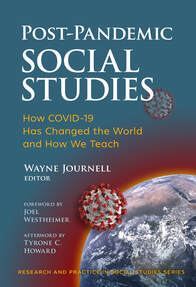
Post-Pandemic Social Studies: How COVID-19 Has Changed the World and How We Teach, edited by Wayne Journell (2022)
COVID-19 offers a unique opportunity to transform the K–12 social studies curriculum, but history suggests that changes to the formal curriculum will not come easily or automatically. This book was conceived in the space between the dismantling of our old way of life and the anticipation of what comes next. The authors in this volume―leading voices in social studies education―make the case that COVID-19 has exposed deficiencies in much of the traditional narrative found in textbooks and state curriculum standards, and they offer guidance for how educators can use the pandemic to pursue a more justice-oriented, critical examination of contemporary society. Divided into two sections, this volume first focuses on how elementary and secondary educators might teach about the pandemic, both as a contentious public issue and as a
recent historical event. The second section asks teachers to reconsider many long-standing aspects of social studies teaching and learning, from
content and instructional approaches to testing.
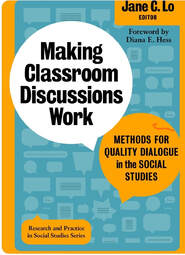
Making Classroom Discussions Work: Methods for Quality Dialogue in the Social Studies, edited by Jane Lo (2022)
For the last 2 decades, the field of social studies education has seen an increase in research on the use of discussions as an essential instructional technique. This book examines the importance of using quality dialogue as a tool to help students understand complex issues in social studies classrooms. The author provides a collection of well-known, evidence-based discussion techniques as well as classroom examples showing the methods in use. While the benefits of using discussion as an instructional method is widely considered a best practice of civic learning, actual high-quality discussions are rare and notoriously difficult to facilitate. Making Classroom Discussions Work is designed to guide teacher educators and classroom teachers in facilitating equitable and productive discussions that will boost learning and democratic engagement.
For the last 2 decades, the field of social studies education has seen an increase in research on the use of discussions as an essential instructional technique. This book examines the importance of using quality dialogue as a tool to help students understand complex issues in social studies classrooms. The author provides a collection of well-known, evidence-based discussion techniques as well as classroom examples showing the methods in use. While the benefits of using discussion as an instructional method is widely considered a best practice of civic learning, actual high-quality discussions are rare and notoriously difficult to facilitate. Making Classroom Discussions Work is designed to guide teacher educators and classroom teachers in facilitating equitable and productive discussions that will boost learning and democratic engagement.
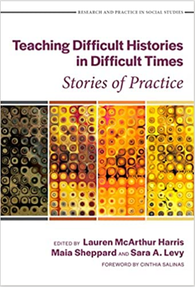
Teaching Difficult Histories in Difficult Times: Stories of Practice, edited by Lauren McArthur Harris, Maia Sheppard, and Sara A. Levy (2022)
Despite limitations and challenges, teaching about difficult histories is an essential aspect of social studies courses and units across grade levels. This practical resource highlights stories of K–12 practitioners who have critically examined and reflected on their experiences with planning and teaching histories identified as difficult. Featuring the voices of teacher educators, classroom teachers, and museum educators, these stories provide readers with rare examples of how to plan for, teach, and reflect on difficult histories. The book is divided into four main sections: Centering Difficult History Content, Centering Teacher and Student Identities, Centering Local and Contemporary Contexts, and Centering Teacher Decision-making. Key topics include teaching about genocide, slavery, immigration, war, racial violence, and terrorism. This dynamic book highlights the practitioner’s perspective to reveal how teachers can and do think critically about their motivations and the methods they use to
engage students in rigorous, complex, and appropriate studies of the past.
Despite limitations and challenges, teaching about difficult histories is an essential aspect of social studies courses and units across grade levels. This practical resource highlights stories of K–12 practitioners who have critically examined and reflected on their experiences with planning and teaching histories identified as difficult. Featuring the voices of teacher educators, classroom teachers, and museum educators, these stories provide readers with rare examples of how to plan for, teach, and reflect on difficult histories. The book is divided into four main sections: Centering Difficult History Content, Centering Teacher and Student Identities, Centering Local and Contemporary Contexts, and Centering Teacher Decision-making. Key topics include teaching about genocide, slavery, immigration, war, racial violence, and terrorism. This dynamic book highlights the practitioner’s perspective to reveal how teachers can and do think critically about their motivations and the methods they use to
engage students in rigorous, complex, and appropriate studies of the past.
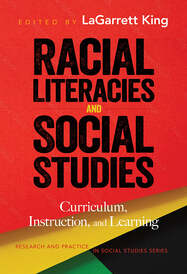
Racial Literacies and Social Studies: Curriculum, Instruction, and Learning, edited by LaGarrett King (2022)
This volume collects the work of historians, researchers, and classroom teachers to define what it means to be a racially literate educator and citizen. History classes should be spaces in which all students learn about their predecessors’ legacies as a context for understanding and decision-making in contemporary society. In reality, the historical experiences of people of color are additive at best or marginalized at worst. To address the complexities of teaching and learning about race in the history classroom, chapter authors answer a series of questions related to curriculum, instruction, student learning, and teacher education: (1) how U.S. history narratives and curricular frameworks can or do incorporate the histories of racial/immigrant groups, (2) how teachers in particular contexts enact instruction that promotes and/or impedes students’ racial literacy, (3) what students learn or don’t learn from race lessons in history, and (4) how teacher educators can educate the next
generation of teachers to become racially literate. Readers can use this resource to enable all young people to acquire the
knowledge skills, and dispositions necessary to critique the nation’s legacy of racial inequality, as well as understand the historical movements to
disrupt inequality.
This volume collects the work of historians, researchers, and classroom teachers to define what it means to be a racially literate educator and citizen. History classes should be spaces in which all students learn about their predecessors’ legacies as a context for understanding and decision-making in contemporary society. In reality, the historical experiences of people of color are additive at best or marginalized at worst. To address the complexities of teaching and learning about race in the history classroom, chapter authors answer a series of questions related to curriculum, instruction, student learning, and teacher education: (1) how U.S. history narratives and curricular frameworks can or do incorporate the histories of racial/immigrant groups, (2) how teachers in particular contexts enact instruction that promotes and/or impedes students’ racial literacy, (3) what students learn or don’t learn from race lessons in history, and (4) how teacher educators can educate the next
generation of teachers to become racially literate. Readers can use this resource to enable all young people to acquire the
knowledge skills, and dispositions necessary to critique the nation’s legacy of racial inequality, as well as understand the historical movements to
disrupt inequality.
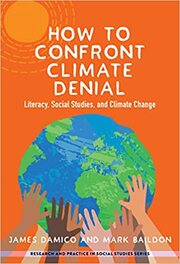
How to Confront Climate Denial: Literacy, Social Studies, and Climate Change, by James Damico and Mark Baildon (2022)
Climate change and climate denial have remained largely off the radar in literacy and social studies education. This book addresses that gap with the design of the Climate Denial Inquiry Model (CDIM) and clear examples of how educators and students can confront two forms of climate denial: science denial and action denial. The CDIM highlights how critical literacies specifically designed for climate denial texts can be used alongside eco-civic practices of deliberation, reflexivity, and counter-narration to help students discern corporate, financial, and politically motivated roots of climate denial and to better understand efforts to misinform the American public, sow doubt and distrust of basic scientific knowledge, and erode support for evidence-based policymaking and collective civic action. With an emphasis on inquiry-based teaching and learning, the book also
charts a path from destructive stories-we-live-by that are steeped in climate denial (humans are separate from nature, the primary goal of society is
economic growth without limits, nature is a resource to be used and exploited) to ecojustice stories-to-live by that invite teachers and students to
consider more just and sustainable futures.
Climate change and climate denial have remained largely off the radar in literacy and social studies education. This book addresses that gap with the design of the Climate Denial Inquiry Model (CDIM) and clear examples of how educators and students can confront two forms of climate denial: science denial and action denial. The CDIM highlights how critical literacies specifically designed for climate denial texts can be used alongside eco-civic practices of deliberation, reflexivity, and counter-narration to help students discern corporate, financial, and politically motivated roots of climate denial and to better understand efforts to misinform the American public, sow doubt and distrust of basic scientific knowledge, and erode support for evidence-based policymaking and collective civic action. With an emphasis on inquiry-based teaching and learning, the book also
charts a path from destructive stories-we-live-by that are steeped in climate denial (humans are separate from nature, the primary goal of society is
economic growth without limits, nature is a resource to be used and exploited) to ecojustice stories-to-live by that invite teachers and students to
consider more just and sustainable futures.
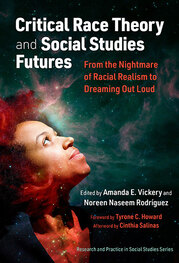
Critical Race Theory and Social Studies Futures: From the Nightmare of Racial Realism to Dreaming Out Loud, edited by Amanda Vickery and Noreen Naseem Rodriguez (2022)
Now more than ever, we need to teach the truth about history. This volume assembles a team of critical social studies Scholars of Color and co-conspirators who share both their nightmares and dreams for the future. The authors engage critical race theory (CRT) and its many branches and offshoots to better understand the permanence of racism in the teaching of social studies. The book’s first section, A Dream Deferred, outlines the endemic systemic issues and the ways in which the field and national organizations attempt to remain racially neutral in the face of the biases that permeate curriculum, disciplines, and the world. The second section, Racial Realities in Classroom Spaces, examines the various ways scholars and educators are applying CRT in PreK–12 spaces. In the third section, Possibilities of Praxis, chapter authors critically reflect on their own
experiences and stories using CRT to work with young people and future teachers. In the final section, Dreaming of Social Studies Futures,
contributors outline their dreams for the future of social studies, envisioning an unapologetically Indigenous field that centers Black futures and
liberation and is free from the violence that has plagued the field and communities for centuries.
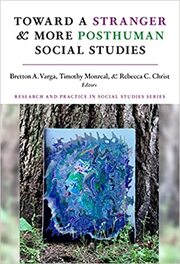
Toward a Stranger & More Posthuman Social Studies, edited by Bretton Varga, Timothy Monreal, and Rebecca Christ (2023)
Posthumanism has seen a surge across the humanities and offers a unique perspective, seeking to illuminate the role that more-than-human actors (e.g., affect, artifacts, objects, flora, fauna, other materials) play in the human experience . This book challenges the field of social studies education to think differently about the precarious status of the world (i.e., climate crisis, ongoing fights for racial equity, and Indigenous sovereignty). By cultivating a greater sense of attunement to the more-than-human, educators and scholars can foster more ethical ways of teaching, learning, researching, being, and becoming. In an effort to push the boundaries of what constitutes social studies, chapter authors engage with a wide range of disciplines and offer unique perspectives from various locations across the globe. This volume asks: How can thinking with posthumanism disrupt
normative approaches to social studies education and research in ways that promote imaginativeness, speculation, and nonconformity? How can a
posthumanist lens be used to interrogate neoliberal, systemic, and oppressive conditions that reproduce and perpetuate in-humanness?
Posthumanism has seen a surge across the humanities and offers a unique perspective, seeking to illuminate the role that more-than-human actors (e.g., affect, artifacts, objects, flora, fauna, other materials) play in the human experience . This book challenges the field of social studies education to think differently about the precarious status of the world (i.e., climate crisis, ongoing fights for racial equity, and Indigenous sovereignty). By cultivating a greater sense of attunement to the more-than-human, educators and scholars can foster more ethical ways of teaching, learning, researching, being, and becoming. In an effort to push the boundaries of what constitutes social studies, chapter authors engage with a wide range of disciplines and offer unique perspectives from various locations across the globe. This volume asks: How can thinking with posthumanism disrupt
normative approaches to social studies education and research in ways that promote imaginativeness, speculation, and nonconformity? How can a
posthumanist lens be used to interrogate neoliberal, systemic, and oppressive conditions that reproduce and perpetuate in-humanness?
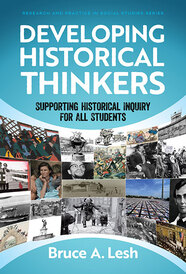
Developing Historical Thinkers: Supporting Historical Inquiry for All Students by Bruce Lesh (2023)
This practical book addresses the consistent questions that were posed by secondary social studies teachers during professional learning sessions. In particular, it examines ways to break through the inclination and perception expressed by many teachers that “My kids cannot do that.” Drawing on 22 years as a high school history teacher, 7 years as a state level curriculum specialist, and extensive work with in-service teachers across the country, the author provides research-based guidance for engaging students in investigating the past. Lesh examines ways to develop effective questions that guide historical inquires, how to utilize discussion in the classroom, and how to align assessment to inquiry. He also shows teachers how to incorporate difficult histories within an inquiry framework. Each chapter uses a specific lesson, framed by student work, to illuminate approaches in real classroom scenarios. Topics include The Pullman Strike of 1894, the Marcus Garvey question, Dust Bowl Migrants, Mao and Communist China, the LGBTQ+ fight for rights, and multiple lessons from World War I. This follow-up to the author’s book "Why Won't You
Just Tell Us the Answer?" fills in gaps and expands tools and classroom examples to assist today’s teachers.
This practical book addresses the consistent questions that were posed by secondary social studies teachers during professional learning sessions. In particular, it examines ways to break through the inclination and perception expressed by many teachers that “My kids cannot do that.” Drawing on 22 years as a high school history teacher, 7 years as a state level curriculum specialist, and extensive work with in-service teachers across the country, the author provides research-based guidance for engaging students in investigating the past. Lesh examines ways to develop effective questions that guide historical inquires, how to utilize discussion in the classroom, and how to align assessment to inquiry. He also shows teachers how to incorporate difficult histories within an inquiry framework. Each chapter uses a specific lesson, framed by student work, to illuminate approaches in real classroom scenarios. Topics include The Pullman Strike of 1894, the Marcus Garvey question, Dust Bowl Migrants, Mao and Communist China, the LGBTQ+ fight for rights, and multiple lessons from World War I. This follow-up to the author’s book "Why Won't You
Just Tell Us the Answer?" fills in gaps and expands tools and classroom examples to assist today’s teachers.
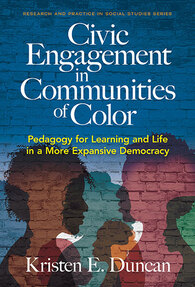
Civic Engagement in Communities of Color: Pedagogy for Learning and Life in a More Expansive Democracy, edited by Kristen Duncan (2023)
Situated at the intersection of race and civics, this volume discusses how communities of color interpret and enact civics both within and beyond the classroom. Chapters focus on historical and contemporary topics ranging from issues facing Asian immigrant communities to the Black Lives Matter at School curriculum. Civic Engagement in Communities of Color will help classroom teachers, teacher candidates, and teacher educators identify where whitewashed civics curricula fail students of color and begin to understand how marginalized communities conceive and enact civics without the deficit lens. It will also help education researchers understand the various frameworks that communities of color use to approach civics and civic education. Chapter authors include established and emerging civic education scholars, including Leilani Sabzalian, ArCasia James-Gallaway, Jesús Tirado, and Brittany Jones.
Situated at the intersection of race and civics, this volume discusses how communities of color interpret and enact civics both within and beyond the classroom. Chapters focus on historical and contemporary topics ranging from issues facing Asian immigrant communities to the Black Lives Matter at School curriculum. Civic Engagement in Communities of Color will help classroom teachers, teacher candidates, and teacher educators identify where whitewashed civics curricula fail students of color and begin to understand how marginalized communities conceive and enact civics without the deficit lens. It will also help education researchers understand the various frameworks that communities of color use to approach civics and civic education. Chapter authors include established and emerging civic education scholars, including Leilani Sabzalian, ArCasia James-Gallaway, Jesús Tirado, and Brittany Jones.
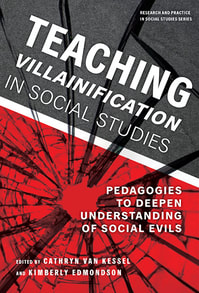
Teaching Villainification in Social Studies: Pedagogies to Deepen Understanding of Social Evils, edited by Cathryn van Kessel and Kimberly Edmondson (2024)
In this collection, scholars from the United States, Canada, and Australia examine the concepts of villainification and anti-villainification in social studies curriculum, popular culture, as well as within sociocultural contexts and their implications. Villainification is the process of identifying an individual or a small group of individuals as the sole source of a larger evil. Anti-villainification considers the messy space in between individual and group culpability in order to help students develop a sense of responsibility to each other as humans in communities on this planet. Chapter authors examine topics related to U.S. politics, financial education, Holocaust education, difficult histories, apocalypse fiction, the Marvel Cinematic Universe, technology use, LGBTQ school experiences, rape culture, geographies of invasion, and the female body. Taken together, these inquiries into villainification offer thoughtful and powerful insights for teaching about historical wrongdoing in more
nuanced ways, addressing the responsibility we all have to create a better world.
In this collection, scholars from the United States, Canada, and Australia examine the concepts of villainification and anti-villainification in social studies curriculum, popular culture, as well as within sociocultural contexts and their implications. Villainification is the process of identifying an individual or a small group of individuals as the sole source of a larger evil. Anti-villainification considers the messy space in between individual and group culpability in order to help students develop a sense of responsibility to each other as humans in communities on this planet. Chapter authors examine topics related to U.S. politics, financial education, Holocaust education, difficult histories, apocalypse fiction, the Marvel Cinematic Universe, technology use, LGBTQ school experiences, rape culture, geographies of invasion, and the female body. Taken together, these inquiries into villainification offer thoughtful and powerful insights for teaching about historical wrongdoing in more
nuanced ways, addressing the responsibility we all have to create a better world.
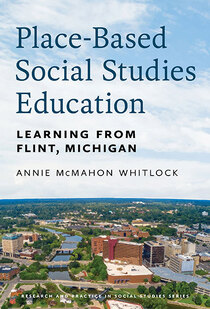
Place-Based Social Studies Education: Learning from Flint, Michigan by Annie Whitlock (2024)
This book uses the water crisis in Flint, Michigan, as a touchstone for the importance and value of including place-based education in the social studies curriculum. Whitlock scrutinizes this local environmental issue to not only drive critical inquiry in the classroom, but also to show how the curriculum can propel valuable social change in the community. Each part of this book highlights critical place inquiry and place-based education with an overall inquiry question: How can schools respond to a community’s needs? How can schooling be reimagined to center “place?” How can teacher preparation be place-based? What did we learn from the Flint crisis and where do we go from here? Individual chapters investigate the inquiry question by examining Flint and the Flint water crisis more specifically, as well as the lessons we can learn from Flint educators. Social studies teachers (Pre-K–16) can use these experiences to inform their own approach to understanding their own places.
This book uses the water crisis in Flint, Michigan, as a touchstone for the importance and value of including place-based education in the social studies curriculum. Whitlock scrutinizes this local environmental issue to not only drive critical inquiry in the classroom, but also to show how the curriculum can propel valuable social change in the community. Each part of this book highlights critical place inquiry and place-based education with an overall inquiry question: How can schools respond to a community’s needs? How can schooling be reimagined to center “place?” How can teacher preparation be place-based? What did we learn from the Flint crisis and where do we go from here? Individual chapters investigate the inquiry question by examining Flint and the Flint water crisis more specifically, as well as the lessons we can learn from Flint educators. Social studies teachers (Pre-K–16) can use these experiences to inform their own approach to understanding their own places.
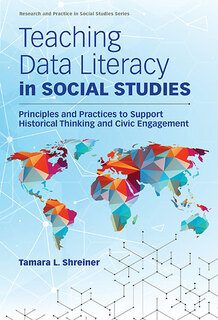
Teaching Data Literacy in Social Studies: Principles and Practices to Support Historical Thinking and Civic Engagement by Tamara Shreiner (coming soon!)
We are surrounded by data and data visualizations in our everyday lives. To help ensure that students can critically evaluate data—and use it to promote social justice—this book outlines principles and practices for teaching data literacy as part of social studies education. The author shows how social studies content and skills can enhance data literacy, and its importance in supporting students’ historical thinking and civic engagement. Shreiner also provides a rationale for including data literacy in the social studies curriculum and highlights the special knowledge and skills social studies teachers offer in promoting a critical, humanistic form of data literacy. Recognizing that many social studies teachers feel poorly equipped to teach data literacy, this book offers practical advice, summaries of the benefits and challenges to students, guidance for incorporating data literacy across elementary and secondary grades, and strategies to help students analyze, use, and create data visualizations.
We are surrounded by data and data visualizations in our everyday lives. To help ensure that students can critically evaluate data—and use it to promote social justice—this book outlines principles and practices for teaching data literacy as part of social studies education. The author shows how social studies content and skills can enhance data literacy, and its importance in supporting students’ historical thinking and civic engagement. Shreiner also provides a rationale for including data literacy in the social studies curriculum and highlights the special knowledge and skills social studies teachers offer in promoting a critical, humanistic form of data literacy. Recognizing that many social studies teachers feel poorly equipped to teach data literacy, this book offers practical advice, summaries of the benefits and challenges to students, guidance for incorporating data literacy across elementary and secondary grades, and strategies to help students analyze, use, and create data visualizations.
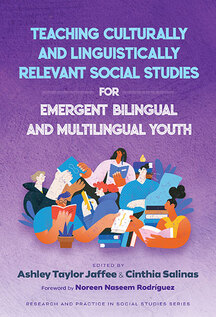
Teaching Culturally and Linguistically Relevant Social Studies for Emergent Bilingual and Multilingual Youth, edited by Ashley Taylor Jaffee and Cinthia Salinas (coming soon!)
Through research, storytelling, curriculum development, and pedagogy, this book will help educators engage emergent bilingual and multilingual (EBML) students with social studies and citizenship education. Chapters are written by well-known and new scholars who are enacting teaching and research that center the needs, interests, and experiences of EBML youth. Drawing from multiple, intersecting, and interdisciplinary frameworks that focus on culture and language, chapters highlight social studies in varying disciplinary and nondisciplinary spaces (e.g., community, geography, family, civics, history) both inside and outside the classroom. Examples of frameworks include culturally relevant and sustaining pedagogies, linguistically responsive teaching, LatCrit and critical pedagogy, translanguaging pedagogy, and transnational citizenship. This insightful volume also directly challenges oppressive structures, policies, and practices that continually marginalize EBML students and are rooted in racism, linguicism, and xenophobia. This unique collection is designed for scholars, teachers,
and teacher educators to actively read, reflect on, and enact the approaches shared by educators who are doing this work.
Through research, storytelling, curriculum development, and pedagogy, this book will help educators engage emergent bilingual and multilingual (EBML) students with social studies and citizenship education. Chapters are written by well-known and new scholars who are enacting teaching and research that center the needs, interests, and experiences of EBML youth. Drawing from multiple, intersecting, and interdisciplinary frameworks that focus on culture and language, chapters highlight social studies in varying disciplinary and nondisciplinary spaces (e.g., community, geography, family, civics, history) both inside and outside the classroom. Examples of frameworks include culturally relevant and sustaining pedagogies, linguistically responsive teaching, LatCrit and critical pedagogy, translanguaging pedagogy, and transnational citizenship. This insightful volume also directly challenges oppressive structures, policies, and practices that continually marginalize EBML students and are rooted in racism, linguicism, and xenophobia. This unique collection is designed for scholars, teachers,
and teacher educators to actively read, reflect on, and enact the approaches shared by educators who are doing this work.
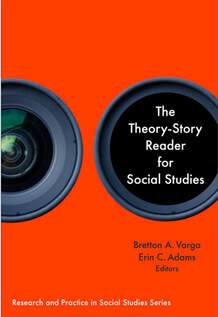
The Theory-Story Reader for Social Studies, edited by Bretton Varga and Erin Adams (coming soon!)
Theory holds the capacity to help educators see the world differently, challenge problematic assumptions and practices that cultivate harm, and illuminate pathways towards access, equity, justice, joy, and love. While it is easy to underestimate the role of theory in such pursuits throughout social studies education, this book shows that theory is always-already present in all productions of teaching and learning. In this collection, well-established scholars highlight a broad range of theories that are currently being used to alter the landscape of social studies instruction. Important to these efforts is the position that theory does not exist in a vacuum but rather is the reflection of a certain set of concepts and the relationship that one holds to those ideas. Taking this further, each chapter author employs storytelling as a means to share their personal history and unpack how they came to understand their selected theoretical topic. They address a breadth of concepts, such as Black feminism, psychoanalysis, racial capitalism, settler colonialism, sustainability, and technoskepticism.
Theory holds the capacity to help educators see the world differently, challenge problematic assumptions and practices that cultivate harm, and illuminate pathways towards access, equity, justice, joy, and love. While it is easy to underestimate the role of theory in such pursuits throughout social studies education, this book shows that theory is always-already present in all productions of teaching and learning. In this collection, well-established scholars highlight a broad range of theories that are currently being used to alter the landscape of social studies instruction. Important to these efforts is the position that theory does not exist in a vacuum but rather is the reflection of a certain set of concepts and the relationship that one holds to those ideas. Taking this further, each chapter author employs storytelling as a means to share their personal history and unpack how they came to understand their selected theoretical topic. They address a breadth of concepts, such as Black feminism, psychoanalysis, racial capitalism, settler colonialism, sustainability, and technoskepticism.